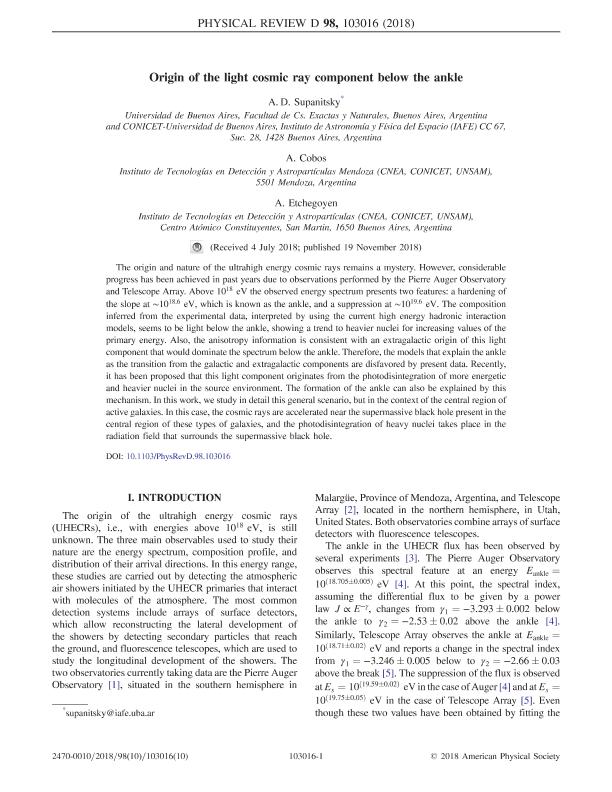Mostrar el registro sencillo del ítem
dc.contributor.author
Supanitsky, Alberto Daniel

dc.contributor.author
Cobos, A.
dc.contributor.author
Etchegoyen, Alberto

dc.date.available
2020-02-17T18:56:16Z
dc.date.issued
2018-11
dc.identifier.citation
Supanitsky, Alberto Daniel; Cobos, A.; Etchegoyen, Alberto; Origin of the light cosmic ray component below the ankle; American Physical Society; Physical Review D: Particles, Fields, Gravitation and Cosmology; 98; 10; 11-2018; 1-10; 103016
dc.identifier.issn
2470-0029
dc.identifier.uri
http://hdl.handle.net/11336/97774
dc.description.abstract
The origin and nature of the ultrahigh energy cosmic rays remains a mystery. However, considerable progress has been achieved in past years due to observations performed by the Pierre Auger Observatory and Telescope Array. Above 1018 eV the observed energy spectrum presents two features: a hardening of the slope at ∼1018.6 eV, which is known as the ankle, and a suppression at ∼1019.6 eV. The composition inferred from the experimental data, interpreted by using the current high energy hadronic interaction models, seems to be light below the ankle, showing a trend to heavier nuclei for increasing values of the primary energy. Also, the anisotropy information is consistent with an extragalactic origin of this light component that would dominate the spectrum below the ankle. Therefore, the models that explain the ankle as the transition from the galactic and extragalactic components are disfavored by present data. Recently, it has been proposed that this light component originates from the photodisintegration of more energetic and heavier nuclei in the source environment. The formation of the ankle can also be explained by this mechanism. In this work, we study in detail this general scenario, but in the context of the central region of active galaxies. In this case, the cosmic rays are accelerated near the supermassive black hole present in the central region of these types of galaxies, and the photodisintegration of heavy nuclei takes place in the radiation field that surrounds the supermassive black hole.
dc.format
application/pdf
dc.language.iso
eng
dc.publisher
American Physical Society

dc.rights
info:eu-repo/semantics/openAccess
dc.rights.uri
https://creativecommons.org/licenses/by-nc-sa/2.5/ar/
dc.subject
Cosmic rays
dc.subject
Light component
dc.subject.classification
Astronomía

dc.subject.classification
Ciencias Físicas

dc.subject.classification
CIENCIAS NATURALES Y EXACTAS

dc.title
Origin of the light cosmic ray component below the ankle
dc.type
info:eu-repo/semantics/article
dc.type
info:ar-repo/semantics/artículo
dc.type
info:eu-repo/semantics/publishedVersion
dc.date.updated
2019-10-24T18:18:48Z
dc.journal.volume
98
dc.journal.number
10
dc.journal.pagination
1-10; 103016
dc.journal.pais
Estados Unidos

dc.journal.ciudad
Nueva York
dc.description.fil
Fil: Supanitsky, Alberto Daniel. Consejo Nacional de Investigaciónes Científicas y Técnicas. Oficina de Coordinación Administrativa Ciudad Universitaria. Instituto de Astronomía y Física del Espacio. - Universidad de Buenos Aires. Facultad de Ciencias Exactas y Naturales. Instituto de Astronomía y Física del Espacio; Argentina
dc.description.fil
Fil: Cobos, A.. Consejo Nacional de Investigaciones Científicas y Técnicas. Oficina de Coordinación Administrativa Parque Centenario. Instituto de Tecnología en Detección y Astropartículas. Comisión Nacional de Energía Atómica. Instituto de Tecnología en Detección y Astropartículas. Universidad Nacional de San Martín. Instituto de Tecnología en Detección y Astropartículas; Argentina
dc.description.fil
Fil: Etchegoyen, Alberto. Consejo Nacional de Investigaciones Científicas y Técnicas. Oficina de Coordinación Administrativa Parque Centenario. Instituto de Tecnología en Detección y Astropartículas. Comisión Nacional de Energía Atómica. Instituto de Tecnología en Detección y Astropartículas. Universidad Nacional de San Martín. Instituto de Tecnología en Detección y Astropartículas; Argentina
dc.journal.title
Physical Review D: Particles, Fields, Gravitation and Cosmology

dc.relation.alternativeid
info:eu-repo/semantics/altIdentifier/doi/http://dx.doi.org/10.1103/PhysRevD.98.103016
dc.relation.alternativeid
info:eu-repo/semantics/altIdentifier/url/https://journals.aps.org/prd/abstract/10.1103/PhysRevD.98.103016
Archivos asociados
